By Jim Dickson
Fire making is a basic skill that too few have today, but in an outdoors emergency, it can be a life-saver.
With fall hunting seasons just over the horizon, this is a good time to sharpen your fire-starting skills.
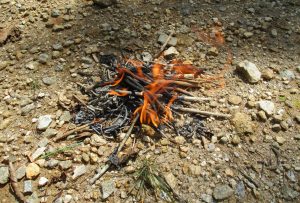
The fire is soon blazing and you must add more fuel or it will go out.
Most folks can eventually get a fire going in the woods but watching tenderfeet try can produce high comedy. I remember camping at a public hunting area where Betty and I were asked by a woman to help her start a fire. She said she just couldn’t get hers started.
When we got to her campsite she showed us how she had been trying. There was a freshly downed tree between 3 and 4 feet in diameter. She was standing as far away as possible, striking matches and fearfully throwing them at that immense tree, apparently expecting it to erupt like a napalm bomb. I told her there was no way I could use that monolith for a campfire but I would build her a fire, which I did.
There was also an arrogant Boy Scout loudly proclaiming that building a teepee out of sticks like they did in the Scouts was the only way anyone could ever get a fire started. No other way would ever work for anyone, he claimed. When he could not get one started, I ended up having to build his fire also and I did NOT use his method after his arrogant display.
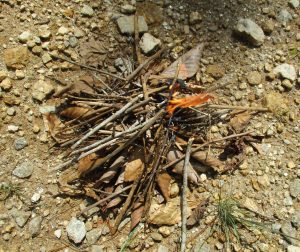
Add larger sticks as the fire picks up
My Betty was the fastest fire maker of all time. If she was cold and we stopped moving for a minute, there would be a fire almost instantly from whatever materials were at hand. I have had Northwoods Indians standing open mouthed at how fast she would make a fire appear with just one cardboard match. This was a very welcome skill when we had Alaskan trapper’s licenses and were living in a one room log cabin deep in the Alaskan interior.
Back in Georgia I will always remember a group of hunters that stopped to talk with us as everyone was returning to their camps at dark. Betty was cold and more interested in fire than talk. Suddenly their mouths popped open and one exclaimed “It took us a gallon of Coleman Lantern Fuel to start our fire and she just made one out of nothing!” Obviously a basic human skill was lacking there, hence this article.
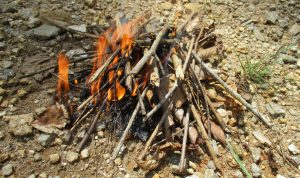
One cardboard match and the fire is lit.
For openers, you do not start with the big logs. You begin with the small starter of dry grass, leaves, and pine or fir needles and lay small dry twigs over it. One cardboard match should be all you need to start it. If the wind is blowing shield the match with one hand as you strike the match with the other.
You should do this right at the material you want to light so you don’t have to move the match. It should be engaged in igniting your fire even as it first blazes up. This is a critical part many people ignore. They will try to strike a match in a hurricane 40 feet from where they want to set something alight and wonder why they can’t keep the match lit long enough. As soon as the twigs begin to catch fire (but not before) begin feeding more twigs followed by larger ones as they catch up.
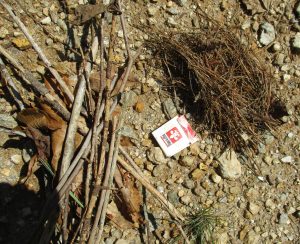
Put the straw and the dry leaves on the bottom and the dry twigs on the top
Now is the time for the small sticks that most people think they are supposed to start with as you keep adding larger bits of wood until your fire is the size you want. Remember that the American Indians never went in for the blazing bonfires the white man often built and neither did the long hunters and other frontiersmen. The bigger the fire the harder you will have to work keeping enough fuel to it to keep it from going out. Just build one as big as you need and then make life easier for yourself by stopping there.
There are many types of tinder and they are important for those making fire with flint and steel. Char cloth is the old favorite and modern folks often use dryer lint and other tinders also. They are far less important for those with a cardboard match or a cigarette lighter. A cheap butane lighter works for thousands of lights rain or shine and the old fashioned ones that used lighter fluid were a mainstay for many woodsmen over the years. Pack a small can of lighter fluid with them along with a card of extra flints and you were good for years of fires without ever coming out of the wilderness.
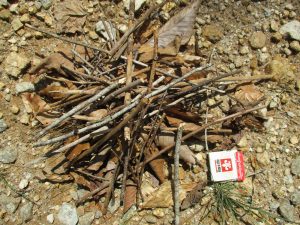
Fire building materials- small dry twigs, dry leaves, dry pine straw and one cardboard match.
For those who want a fire starter for wet weather the trick birthday candles that cannot be blown out rate number one. Cotton balls soaked in Vaseline also will candle and start fires. Standing dead wood will be dry inside. Cedar burns well in the worst conditions as does resinous fatwood. When Betty and I needed a fire in a hurry in bad conditions we found nothing beat a wax fire log cut in half by the axe and the cut end inserted in a paper bag and sealed off with masking tape to prevent it crumbling away. That trick proved a valuable shortcut at various times. It still needed the small fire starting techniques mentioned earlier to get it going unless you also had packed some wadded up paper to get it started.
Use common sense building the fire. I have known individuals who try to build a fire on top of snow and ice as well as under snow covered trees where the snow will melt and fall on the fire and put it out. Clearing a place for the fire so you don’t start a forest fire seems basic but you would not believe how many forest fires are started by people building a fire on a forest floor covered with dry pine needles and leaves. Try to find a place sheltered from the wind and rain as much as possible.
Now you know why our ancestors liked living in caves. Start small and build up instead of trying to have it full size at the beginning and you will always be able to have a fire with one match.



